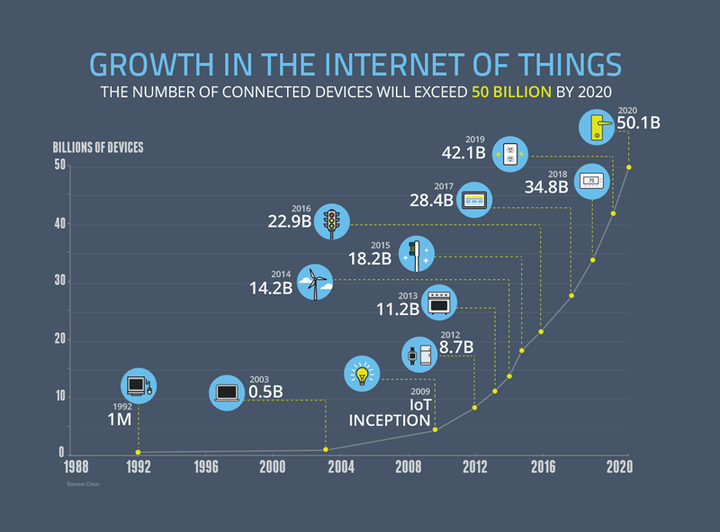The number of connected devices on the Internet will exceed 50 billion by 2020, this according to Cisco. By 2022, 1 trillion networked sensors will be embedded in the world around us, with up to 45 trillion in 20 years.

Growth in the Internet of Things
Here are Cisco’s network growth forecasts based on greater adoption of mobile, wireless and IoT technologies:
- Annual global IP traffic will reach 3.3 ZB (ZB; 1000 Exabytes [EB]) by 2021. By 2021, global IP traffic will reach 3.3 ZB per year, or 278 EB per month.
- Global IP traffic will increase nearly threefold over the next 5 years, and will have increased 127-fold from 2005 to 2021. Overall, IP traffic will grow at a Compound Annual Growth Rate (CAGR) of 24 percent from 2016 to 2021.
- Smartphones will account for 33 percent of total IP traffic in 2021, up from 13 percent in 2016.
- Traffic from wireless and mobile devices will account for more than 63 percent of total IP traffic by 2021. By 2021, wired devices will account for 37 percent of IP traffic, while Wi-Fi and mobile devices will account for 63 percent of IP traffic.
- Globally, Internet traffic will reach 30 GB per capita by 2021, up from 10 GB per capita in 2016.
- The number of devices connected to IP networks will be three times as high as the global population in 2021. There will be 3.5 networked devices per capita by 2021, up from 2.3 networked devices per capita in 2016.
- Broadband speeds will nearly double by 2021. By 2021, global fixed broadband speeds will reach 53.0 Mbps, up from 27.5 Mbps in 2016.
According to Boston Consulting Group (BCG), B2B spending on Internet of Things (IoT) technologies, apps and solutions will reach $267B by 2020, with 50% of IoT spending will be driven by discrete manufacturing, transportation and logistics, and utilities.

Services and IoT apps and analytics will capture 60% of IoT spending by 2020
To learn more Internet of Things industry and market trends, Ray Wang and I invited an IoT innovation expert and a bestselling author to our weekly show DisrupTV.

Maciej Kranz, vice president of Corporate Strategic Innovation Group at Cisco
Maciej Kranz is vice president of Corporate Strategic Innovation Group at Cisco. Kranz brings 30 years of computer networking industry experience to his position as Vice President of Strategic Innovation at Cisco. He leads the group focused on incubating new businesses, accelerating internal innovation, and driving co-innovation with customers and startups through a global network of Cisco Innovation Centers. Prior to this role, he was general manager of Cisco’s Connected Industries Group, where he drove IoT business for key industrial markets. In his new book, Building the Internet of Things, Kranz offers practical advice to business decision makers on how and why to implement IoT today.
With over $1.46 trillion projected to be spent on The Internet of Things (IoT) in year 2020, no other technology trend will more dramatically impact the near future, but how can businesses prepare for this revolution now? In BUILDING THE INTERNET OF THINGS: Implement New Business Models, Disrupt Competitors, and Transform Your Industry), Kranz, who is one of the earliest pioneers of IoT who helped name it, transforms hype into reality and shows any business how to implement IoT.
Here are the key IoT takeaways from our conversation with Kranz:
1. Today’s IoT is more about business impact and less about consumer usage - According to Kranz, the two of the biggest misconceptions about IoT are: 1. IoT is about connecting devices and 2: IoT is about connected home (inter-connecting devices in the home). Kranz expected major innovation in IoT to come from the consumer space, but today, IoT innovation is mostly in the enterprise and B2B. Business are seeing compelling business use cases with connected devices, therefore they are developing products that are connected.
“In fact, we see most of the applications of IoT in the business environment; however, down the road, I do expect key innovations to emerge in the consumer segment (but we are not there yet). Today, IoT is about business impacts driven by IoT solutions built around connected devices, data they generate, and applications.” — M Kranz
2. Investors can find IoT adoption across a wide range of industries - According to Kranz, the adoption of IoT has been broad. A few years ago, VCs were conservative in terms of investments in IoT. Today, Cisco has 14,000 IoT customers across multiple industries. An example is smart and connected cities and their use of IoT. The VC community is starting to invest more in IoT. “According to my own observations and research houses such as Ovum or McKinsey, IoT has been mostly adopted in manufacturing, logistics, transportation but also in retail, healthcare, agriculture, smart cities, and even sports and entertainment,” said Kranz.
3. IoT is creating business disruption opportunities outside of the tech industry - Kranz spoke about the tech industry and the cycle of reinvention measured in 307 years. Traditional business models, with vertically integrated business models, are ripe for disruption based on the rate of innovation. “Traditionally, in the technology industry companies need to re-invent themselves every 3-7 years to survive. If the company misses one transition, it can still recover, but if it misses two, it is usually fatal. However, IoT is now bringing the same model to other industries,” said Kranz. The autonomous vehicle industry is a good example.
“The companies that stick to traditional business models, closed systems and one company providing a complete solution approaches will be the losers. The companies that adopt change as a way of doing business, that open up their offers and processes and who embrace collaborating with an ecosystem approach to develop solutions will be the winners.” — M Kranz
4. Lack of education and unclear messaging are key obstacles for IoT adoption in business - Kranz reminds us that business transformation is less about technology and more about culture, a new mindset, business structures, change management and security. Regarding IoT adoption, Kranz tells us that some businesses simply have not researched IoT and lack the knowledge to formulate a game plan. Other businesses are confused by all the technology centric or future-oriented messaging they are hearing. This said, Kranz notes that 1000s of customers have started on the IoT journey. Cisco is a company that has a strong tradition of education stakeholders, so there is no surprise that they currently have more than 14,000 IoT customers.
5. Industry gains as a result of IoT implementations will exceed $1 trillion dollars - In his book, Kranz describes industry gains that are achieved via IoT across agriculture, city planning, education, healthcare, retail, sports and entertainment, and the military. McKinsey & Co. projects that the first nine impacted industry segments of IoT will expand as follows:
- Vehicles: autonomous vehicles and condition-based maintenance ($210 to $740 billion)
- Cities: public health, energy saving, and transportation & logistics ($930 billion to $1.7 trillion)
- Outside: logistics and navigation ($560 billion to $850 billion)
- Human: health and fitness ($170 billion to $1.6 trillion)
- Worksites: operations optimization and health & safety ($160 billion to $930 billion)
- Retail environments: automated checkout ($410 billion to $1.2 trillion)
- Factories: operations and equipment optimization ($1.2 billion to $3.7 trillion)
- Offices: security and energy ($70 billion to $150 billion)
- Home: chore automation and security ($200 billion to $350 billion)
6. Advice to a small or midsize business leader who is just beginning to explore IoT implementation - There are thousands of IoT implementations already, the integration channel has matured, so small and midsize companies do not have to be trailblazers, they can simply follow existing best practices. Kranz highlights the following advice from his book regarding early IoT implementations:
- Create your big vision (where you want your organization to be in 10 years)
- Identify first a small project (thousands of your peers have implemented these solutions already, several highlighted in Kranz’s book)
- Find an integrator that has experience in the use case that you want to implement and experience in your industry
- Gather stats and benchmarks in the industry and compare them to your own Total Cost of Ownership
- Build your business case for the first project
- Get C-suite sponsorship – this is essential, you are not embarking on one project, you starting to transform your organization
- Establish a partner ecosystem – you will need them starting with your first project
7. Adoption of IoT is a must if you want your business to survive - We asked Kranz to project 10-15 years from now and discuss the future of IoT. Kranz noted that the rate of change is accelerating across all major industries. The convergence of technology (mobile, social, cloud computing, big data, artificial intelligence, VR/AR, Blockchain, 3D printing, and IoT) and new business models are disrupting “old” industries. Kranz projected that in 10 years, we will not be speaking about IoT anymore. Today, we don’t talk about e-commerce, we just do it. In 10 years, IoT will be deeply integrated into our everyday life and businesses. Every company will be a technology company, with new business models emerging based on IoT. Service oriented business models with mass personalization at scale will be enabled by IoT. IoT is a foundation for other amazing innovation models and use of emerging technologies like AI and blockchain. The combination of IoT, AI and blockchain will be transformative.
8. Driver for IoT implementations is process efficiency, speed and business agility - Kranz reminded us that in the business world, you tend to follow the money. “The biggest impact of IoT in the short-term has been on dramatically improving and automating archaic and manual processes in many traditional industries. For example, in the construction industry so much is still done using pen and pencil. Thus, by connecting devices and processes within the enterprise, IoT is brining immediate top and bottom line impacts,” said Kranz.
Maciej Kranz is an IoT innovation expert and a business transformation trailblazer. I encourage you to watch our video conversation for Kranz to learn more. I also highly encourage you to read his book BUILDING THE INTERNET OF THINGS for fantastic and very specific industry use cases of IoT.
